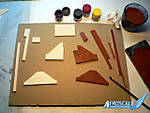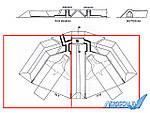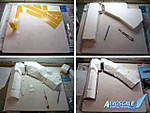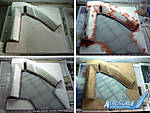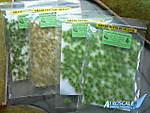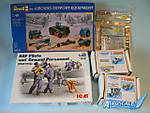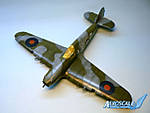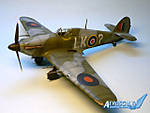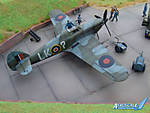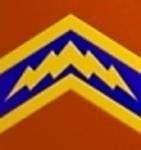1⁄35RAF Dispersal Pen Diorama
18
Comments
Introduction
The night intruder operation was a specialist exercise requiring a pilot with keen eyesight, cool nerves, and the ability to seize a chance that would only last seconds. It involved flying a lone fighter over to the enemy's own airfields and seeking to destroy his bombers as they were taking off or landing. As such, it was a particularly furtive operation where success came from striking an opponent in the back when he was least expecting it.Usually intruder activity took place during the two weeks around a full moon, known by the pilots involved as "the moon period". The moon assisted flying as well as the location of enemy bombers. As they waited for an operation, intruder pilots would tend not to read or write because the whiteness of the page would have dulled their vision. Indeed some pilots would prepare for such sorties by wearing 'dimmer' glasses - goggles with dark lenses - which protected their eyes from lights and accustomed them to the darkness which lay ahead.
In the course of the year or so that the RAF carried out these night intruder operations (Spring 1942-Spring 1943), the tactics rapidly went through various phases before settling on a combination of all of them.
At first, the RAF waited for the watchers on the coast to notify them that German bombers were on their way across the Channel seeking English targets. As soon as the Luftwaffe was over English soil, a few pilots would then set off singly and head for the Continent. They had to guess, from the direction of the bombers, which airfields the Germans were using. They would circle the enemy's bases, waiting for the Luftwaffe bombers to return. When the Germans did come back, they were at their most vulnerable: low on fuel, possibly the ammunition used up, and the crews tired and unsuspecting. The navigation lights and the slow speed of the bombers as they descended to the ground, plus the lights on the runway, all assisted the British pilot in locating and destroying the enemy.
The next phase came when it was decided to take more of the initiative, fly over to France early in the night, and try to find German bombers as they were actually taking off. This was a riskier kind of operation: the German crews were alert and the ammunition racks were full of rounds. Yet it had the marvellous advantage that, if successful, the sortie not only destroyed the enemy aircraft but also its bomb load which could not then be dropped on English targets.
The third phase grew up when the intruders could not find any aircraft to hit and, rather than return with the rubber sheaths still over the protruding cannon barrels, they looked for trains to attack. Railway lines usually stood out well in the black-out because they were so much straighter than roads. Trains betrayed themselves by red and yellow sparks from the engine and by plumes of smoke which gave the pilot some indication of wind direction and strength. The RAF told its pilots that the Germans imposed a strict curfew on the French and would not allow them to travel by night, so normally pilots would have no compunction about strafing the wagons and carriages as well as the engines.
In fact, the chances of finding and finishing German aircraft were low. Night after night, many of the pilots would not even see an enemy aircraft, let alone engage or destroy one. The Luftwaffe aircraft often returned to a different airfield than the one from which they had taken off and they had something like twenty bases from which to choose.
The Hurricane intruder operation was a lonely and dangerous kind of mission. Unlike the Douglas Havocs and de Havilland Mosquitoes which also performed night intruder operations, the Hurricanes had one engine and a single crew member. If the Merlin engine failed or the aircraft was badly damaged, the pilot would have to crash-land his aircraft and he was on his own. Navigation was almost by 'feel'. The pilot had to have one hand permanently on the control column and the Hurricane only had two little red cockpit lights, so there was no way to unfold cumbersome maps or - if one could - see them at all distinctly. Each aircraft was invariably alone, flying over enemy territory in the vicinity of well-defended airfields in circumstances which made them visible to the Germans. It is astonishing that there were not more fatalities.
Source: www.rogerdarlington.co.uk/Hurricane.html
Building the Dispersal Pen Structure
To build the diorama, I used a 54X54 cm piece of wood. Why 54 X 54 cm? Because it was the size of the tables we replaced in my Art Classroom last year and I recovered about forty of these plates for future projects. By putting several together, I might be able to reproduce a whole RAF airfield replica in 1/48 scale one day... or maybe in another life.To build up the banks of the Dispersal Pen, I used foam which I cut to shape. The brick wall structure was purchased from Mark58, a French diorama product manufacturer. I often sent pictures of the project per e-mail to Marc Toillié, owner of Mark58, to have the opinion of an expert, because there are not many pictures of Dispersal Pens in their original state available today. Once the basic shape was found satisfactory by both of us I applied a coat of plaster. Later I made some adjustments using modelling clay and once thoroughly dry, everything was secured under a coat of resin. I always do that when I use foam or plaster in my dioramas to give more strenght to the assembly.
The Mark58 brick walls parts where painted using Tamiya acrylics and then weathered with pastels. When I purchased this Dispersal Pen set last year, Marc Toillié made all his products in white. Today he adds pigments to the acrylic resin he is using and his whole range of diorama items are pre-coloured for ease of use.
Once the basic work was done, the diorama was airbrushed with several coats of paint (brown and grey). As you can see, I pre-shaded the area which represents the concrete in a first step of weathering. Several layers of artificial grass where then applied on the brown surface and Silflor Grass Tufts were added to break the too even surface of the grass.
Actors and Accessories
Now that the set was ready, it was time to think about the actors and the accessories. To date, the best RAF figures in 1/48 scale can be found in ICM's RAF Pilots and Ground Personnel set (kit N°48081) so I choosed to use several of them. I also picked up some equipment in the same box such as a ladder and the compressed air bottles carriage. More nice British stuff can be found in Revell's WWII Ground Support Equipment set (kit N°04511): an accumulator trolley and an oil bowser. Since I also wanted to add a vehicle, I decided to build one from the new Accurate Armor line of 1/48 scale kits. I found the Standard Tilly Truck would suit better to this diorama than the David Brown Tractor. Finally, I had some Flightpath products in my stash in case all the items I gathered wouldn't have sufficed.As I said previously, the figures of the ICM set are great. With a nice paintjob they look awsome and have yet to be superseeded in injected plastic or even in resin. If you find such an ICM RAF set, don't hesitate and buy one as it represents great value for money. The same can be said about the Revell set because it also includes some nice German and U.S. WW2 airfield equipment which represent a perfect accompaniment for an aircraft model. Both the trolley and the bowser are reasonably detailed and were easy to build. I painted both in blue, applied a wash et voilà!
The Accurate Armor Truck was also a joy to build even if more work was necessary. This is not surprising as it is a resin kits with microscopic photo etched detail parts. The kit went together with no major problems, the only trouble was the presence of some air bubbles (see red arrows on the pictures). I decided to slightly modify the canvas cover of the truck to represent it in the open position. To do so I've eliminated the back hanging, scratchbuilt a new one with Tamiya two part Epoxy (Quick dry type) and placed it rolled up on the roof of the truck. The painting was done according to the instructions in Green with additional black "Mickey Mouse Ears" style camouflage.
From the Flightpath stuff I only used one bicycle (women style) and a warning sign. For the first time in my modelling life I used an Etch Mate! It was mandatory since I didn't manage to properly bend the metal Flightpath used for their PE parts. Without an appropriate tool it is virtually impossible! However, once finished both the bicycle and the sign look very convincing. Once all the figures and equipment were placed in the diorama, it was obvious that the right upper corner needed some animation. I decided to place a dog and two sheeps since these were often used as cheap an autonomous lawn mower at that time and this way the scene's got it's buccolic touch. By the way, I found the animals in Pegasus Hobbies' Farm Animals box (kit N°7006). If you need cheeps, dogs, pigs, cows, hens, turkeys, birds etc... you know where you have to look now.
The main character: the Hurricane Mk IIC
When I started this diorama, I didn't had an appropriate model in my collection. In the late 30', Dispersal Pens were built in two sizes: for fighters (Spitfires and Hurricanes) and for medium bombers (Blenheims). Obviously I reproduced a smaller Dispersal so I had to choose between the two most emblematic RAF fighters of the era. Finally I decided to include a model of Hawker's famous plane.The kit I've built for this project is Revell's reboxing of Hasegawa's Mk IIC. I must say I wasn't surprised at all by the kit. I've built many Hasegawa kits in the past and excepted for the many optional parts which needed carefull alignment, no major problems were encountered. It's too bad that the kit only includes a closed canopy though, otherwise I would have left it open to show the detailed cockpit interior, the latter only needing some aftermarket seatbelts to look realistic. The model was built "out of the box" (except for the aformentionned seatbelts) and I only hollowed the exhaust stacks and the gun openings to add realism. To obtain that "oily metallic" effect on the barrels I simply painted them silver and then applied a dark brown wash of Future.
I decided to paint the model in an "Night Intruder" paint scheme because I thought it would suit perfectly to the scene... and also because it was a nice change from the blue or grey underside colors of most of the models I did so far. I kept the weathering to a minimum (for my standards in any case) and once done the plane was placed in the central position of the Dispersal.
The story
September 1942, somewhere in England, late in the evening. A small truck has just stopped in front of a dispersal pen and debarked two RAF pilots. One of them is currently receiving some recommendations from another pilot who flew a Night Intruder mission the day before. Tonight, someone else has to do the job...A woman officer, who arrived by bicycle, is awaiting the unfortunate pilot to give him the latest meteorological and intelligence reports. The driver of the truck is unloading two Jerrycans of fuel to supplement the full of the plane whose engine turned a little earlier. After all, it's going to be a long night. The Chief Technical Officer, perched on the wing of the plane, will soon open the hood an then help the pilot to climb into the aircraft.
Completely unaware of the dramatic scene which occurs under their eyes, two sheeps are hardly disturbed by the barking dog of one of the mechanics. In one hour, the Hurricane with it's four 20 mm cannon will fly over Occupied France...
Comments
Excellent work, will use your diorama as referance when I get brave enough to take on a project like yours.
AUG 23, 2007 - 10:53 AM
This is a good diorama, and demonstrates exceptional modelling skills, but I am afraid it fails for me as so many dioramas do on the story it tells. So many times This failiure is in the planning stage, to put it quite simply when you plan a diorama you should look at the logic of the scene. I realise as someone who has many years experience working on flight lines I have an advantage on this, but most of these things are common sense.
For example on this diorama Consider the following points:
Still doing maintenance /refuelling tasks when the pilot arrives?
Believe me a RAF Aircraft Then and now, would be signed up as Servicable and ready to fly long before the "driver" appeared.
Doing maintenance on an armed aircraft?
When a Military aircraft is declared servicable and fully fuelled, Then and only then is it armed. Maintenance is forbidden on armed aircraft. (I can assure you that this was true as far back as in WW1, where no doubt sombody found out the hard way).
A tilly loaded with jerricans of fuel parked in front of an armed aircraft?
I think not! In real life somebody might find himself on a fizzer and spending some time in a warm guardroom cell if he did this.
When the pilot arrives the trolley Acc WILL be connected to the aircraft, and the trolley placed in such a way that the aircraft would have no chance of striking it when taxying out .(especially at dusk!).
I apologise in advance to the maker and imply no personal slight. I mean this as constructive criticism, I am just using this diorama as a convenient example.
But I honestly think i will go mad if I see yet another Diorama with jet aircraft loaded with live missiles in a hangar scenario!
Exasperated Selwyn!
OCT 20, 2010 - 10:08 AM
Hi Steve,
Thank you and I'm glad you found this diorama convenient to make your points. I hope I will do better next time. In fact I'm working on another diorama with a Maryland based in Malta. When the time comes I will post in progress pictures of it and I hope you can give me some useful advices.
Jean-Luc
OCT 20, 2010 - 10:22 AM
Well, be carefull what you wish for
I have actually seen fully fueled and armed F-15 fighters in a hangar when they were on 4 minute scramble standbye at Soesterberg AFB in the Netherlands waiting for some poor soviet plane wondering into NATO skies back in the 80's . They did not even carry any "remove before flight" tags while a heating system was keeping the engine warm.
OCT 20, 2010 - 10:55 AM
Hi Steve and Jean-Luc
Thank you and I'm glad you found this diorama convenient to make your points. I hope I will do better next time. In fact I'm working on another diorama with a Maryland based in Malta. When the time comes I will post in progress pictures of it and I hope you can give me some useful advices.
Jean-Luc [/quote]
first let me state that Steve is probably right,
but I personally find it more important that the story(ies) on a diorama fit. That the figures interact and that the whole layout is "convenient" or convincing. I am more comfortable with Luftwaffe themes and in that area there is "nothing" that is impossible. If you think "that can't be so" someone is showing you a photograph of the real thing ... of course often the exception to the rule but nonetheless possible ....
just my 2 €ct
all the best
Steffen
OCT 20, 2010 - 09:42 PM
Hi Steve
First off - welcome to Aeroscale! It's great to have you with us.
Thanks for the very useful observations - the points are well made and constructive. I agree with Steffen that you are probably correct in most circumstances, and I'll certainly bear them in mind for future builds.
Of course, what often makes things more confusing for any of us who don't have hands-on experience of servicing military aircraft is the posed nature of some wartime photos - the "Right lads! The photographer's here - everybody try to look busy!" effect. Years ago, my family used to know several ex-RAF WW2 pilots (all sadly deceased now) and I well remember one of them scoffing at some of the scenes in books - particularly propaganda shots - when I asked his advice for models.
All the best
Rowan
OCT 20, 2010 - 10:32 PM
I think you will find that that is a QRA shed or Hardened Aircraft Shelter.
A hangar is where you take an aircraft for maintenance!
I have seen kits modelled up on jacks with missiles fitted.
Selwyn
OCT 22, 2010 - 06:35 AM
Is it just me or did some pilots of that time look younger than others?
 Nige
Nige
 Nige
Nige
NOV 02, 2010 - 09:59 AM
ahh, this was ART, and free interpretation by the artist, not modelling
NOV 08, 2010 - 04:19 AM
Copyright ©2021 by Jean-Luc Formery. Images also by copyright holder unless otherwise noted. The views and opinions expressed herein are solely the views and opinions of the authors and/or contributors to this Web site and do not necessarily represent the views and/or opinions of AeroScale, KitMaker Network, or Silver Star Enterrpises. Images also by copyright holder unless otherwise noted. Opinions expressed are those of the author(s) and not necessarily those of AeroScale. All rights reserved. Originally published on: 2007-08-04 00:00:00. Unique Reads: 28356






